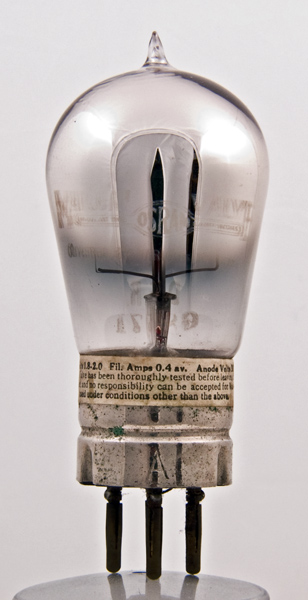|
Research post WWI lead to the developing of thoriated Tungsten filaments that emitted electrons at lower temperatures (1,700°C) than pure Tungsten (2,400°C). The first produced in the UK was the GEC LT1 that became the prototype for the 1922 DER.

An example of an early DER valve complete with paper label
Early Dull Emitter Receiving valves had their electrode systems mounted vertically and were not gettered eg DER. This was too prone to vibration and hence microphonic so the design reverted to the sturdier arrangement used in tried-and-tested R valves.
A persistent, problem was premature loss of filament emission due to ion bombardment of its thoriated surface. Later it was found that carbonising the filament lead to a greater resistance to the poisoning effects of some residual gasses present within the envelope. This loss of emission was traced to poor vacuum and great efforts were expended in improving this. One solution was to getter the valve, at first using activated phosphorous as the gas-absorbing agent. Valves gettered with phosphorous are instantly recognisable by their ginger coloration eg DER. Unfortunately, it proved impossible to prevent traces of the phosphorous from contaminating the thoriated surface of the filament, with undesirable results.
Other getter agents, including barium and magnesium, were tried until a successful technique was evolved. A barium getter gives rather ugly blackish coloration which was distrusted by customers because it made new valves look 'used' but the addition of magnesium gave the familiar and rather pleasing silvery effect eg DER.
However, even successful gettering did not remove all traces of internal contamination so loss of emission due to ion bombardment continued to be a problem for several years. The number of ions bombarding the cathode, and their potential to cause damage, increases sharply as the anode voltage is raised. It also increases in proportion to the current passing through the valve. It was found that acceptably long lives could be guaranteed in DER valves only by limiting the anode voltage to about half that commonly used with 'brights' such as the R Type. Careful control of filament voltage was also important so the filament rating of the DER was reduced to 1.8V to allow for adjustment using a series rheostat. With these modifications the DER was widely successful and continued in production until at least the late 1930s.
The restriction on anode voltage imposed on the DER meant that its audio out power was sufficient only for headphones. The DE6 was essentially a DER redesigned with a slightly thicker filament and a wider grid pitch to give more current, a lower impedance and a slightly improved slope. These modifications enabled the DE6 to deliver sufficient audio output power to operate a small loudspeaker without requiring a large HT voltage.
See also 1924: Hints on Using Dull Emitter Valves .
|